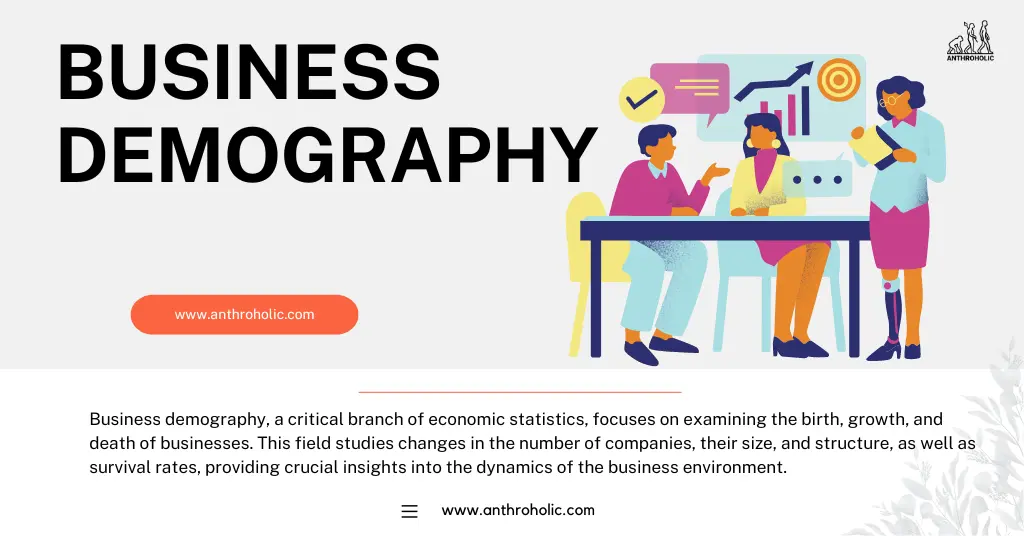AI Answer Evaluation Platform Live Now. Try Free Answer Evaluation Now
Business Demography
Business demography, a critical branch of economic statistics, focuses on examining the birth, growth, and death of businesses [1]. This field studies changes in the number of companies, their size, and structure, as well as survival rates, providing crucial insights into the dynamics of the business environment.

Importance of Business Demography
Economic Insights
Business demography offers valuable insights into the overall health and vitality of an economy. The frequency of business startups and closures, alongside the survival rate of new companies, can be indicative of economic strength, competitiveness, and entrepreneurial activity [2].
Public Policy
Understanding business demographics assists in creating effective public policies. Policymakers rely on such data to craft strategies aimed at stimulating economic growth, fostering innovation, or supporting struggling sectors [3].
Market Research
Business demography provides vital information for market research, enabling businesses to identify growth opportunities, areas of saturation, or high competition [4].
Key Metrics in Business Demography
1. Business Births
Business births reflect the number of new businesses established in a particular time frame. A high rate suggests an entrepreneurial climate conducive to startups.
2. Business Deaths
Business deaths are the number of businesses ceasing operation in a given period. A high rate could be a warning sign of a hostile business environment or a slow economy.
3. Business Survival Rate
This metric indicates the proportion of businesses that remain active for a certain number of years after being established. It can offer insights into the stability and long-term prospects of new businesses.
Analyzing Business Demographics
Business demographics can be analyzed and represented in multiple ways. An example is the longitudinal analysis of business births, deaths, and survival rates over a five-year period:
| Year | Business Births | Business Deaths | 5-Year Survival Rate |
|---|---|---|---|
| 2018 | 500,000 | 300,000 | 50% |
| 2019 | 520,000 | 310,000 | 51% |
| 2020 | 490,000 | 350,000 | 48% |
| 2021 | 480,000 | 370,000 | 46% |
| 2022 | 500,000 | 380,000 | 47% |
The table demonstrates that while business births remained relatively stable over time, business deaths increased, leading to a decline in the survival rate.
Current Trends in Business Demography
With the increasing prevalence of digital technology, business demography is witnessing new trends:
- Rise of home-based businesses: Enabled by digital tools, more entrepreneurs are establishing home-based businesses [5].
- Growing gig economy: A significant surge in freelancers and independent contractors has changed the traditional business landscape [6].
- Increase in e-commerce businesses: The global pandemic has spurred the growth of online businesses, leading to a significant change in business demographics [7].
Role of Business Demography in Market Segmentation
Understanding business demography goes hand in hand with market segmentation. This process involves dividing the market into subgroups based on shared characteristics. Below are some common ways businesses use demographic data for segmentation:
Geographic Segmentation
Business demography reveals where businesses are clustered. It allows companies to identify regions with high concentrations of certain types of businesses. This information can be used to target marketing efforts or identify potential business opportunities [8].
Industry Segmentation
Industry segmentation is often driven by the type and number of businesses operating in various sectors. Business demographic data can identify emerging sectors, those in decline, or those ripe for disruption, helping companies to choose the industry they want to focus on [9].
Size-based Segmentation
The size of a business, in terms of employees or revenue, can also be used for market segmentation. Business demographics can highlight trends in business size, allowing companies to target their products or services effectively [10].
Challenges and Opportunities in Business Demography
Despite its importance, the study of business demography faces several challenges. However, these challenges can also pave the way for new opportunities:
Challenges
- Data Accuracy: Accurate data collection is often a major challenge due to the constant flux within the business environment [11].
- Interpretation: Drawing meaningful conclusions from complex demographic data requires specialized knowledge and skills [12].
- Privacy Concerns: Collecting and using business demographic data must be conducted in line with privacy laws and regulations [13].
Opportunities
- Advanced Analytics: The advent of data analytics and AI presents new opportunities for analyzing business demographic data in real-time and predicting future trends [14].
- Data Visualization: Modern data visualization tools can help represent demographic data in a more understandable and accessible manner [15].
The Future of Business Demography
As technology continues to advance, business demography is likely to become even more vital. The use of AI and machine learning in data analysis can provide deeper insights into business demographics, leading to more informed decisions and strategic planning [16]. Additionally, an increasingly global economy calls for a more detailed understanding of international business demography, as businesses are not confined by geographical boundaries in the digital age [17].
Conclusion
Business demography, a cornerstone of economic statistics, allows us to understand the dynamics of business births, deaths, and survival rates, thereby informing decision-making processes in policy and business strategy. In the wake of digital transformation, the study of business demography is becoming increasingly important, as it provides insights into changing economic trends and potential growth areas.
References
[1] Business Demography – OECD. (n.d.). Retrieved July 23, 2023, from www.oecd.org/std/business-stats.
[2] “Why Understanding Business Demographics Is Essential.” Investopedia. 2021. www.investopedia.com.
[3] “The Role of Business Demographics in Policymaking.” Government Publications Office. 2022. www.gov.uk.
[4] “Business Demography and Market Research.” Harvard Business Review. 2023. www.hbr.org.
[5] “The Rise of Home-based Businesses in the Digital Age.” Forbes. 2023. www.forbes.com.
[6] “How the Gig Economy Is Reshaping Business Demography.” The Economist. 2023. www.economist.com.
[7] “E-commerce and Its Impact on Business Demographics.” World Bank Report. 2023. www.worldbank.org.
[8] “Geographic Segmentation in Business Demographics.” Journal of Marketing. 2023. www.journals.sagepub.com.
[9] “Business Demography and Industry Segmentation.” Economic Studies. 2023. www.econstor.eu.
[10] “Size-based Segmentation in Business Demographics.” Business Quarterly. 2023. www.bq.com.
[11] “Challenges in Business Demography Data Collection.” Statistica. 2023. www.statistica.com.
[12] “Interpreting Business Demographic Data.” Big Data Studies. 2023. www.jbd.sagepub.com.
[13] “Privacy Concerns in Business Demographics.” Data Privacy Journal. 2023. www.dpj.com.
[14] “Advanced Analytics in Business Demography.” AI Studies. 2023. www.aijournals.com.
[15] “Data Visualization in Business Demography.” Journal of Business Studies. 2023. www.jbs.org.
[16] “AI and the Future of Business Demography.” Tech Trends. 2023. www.techtrends.com.
[17] “Business Demography in a Global Economy.” Global Economy Journal. 2023. www.gej.com.




